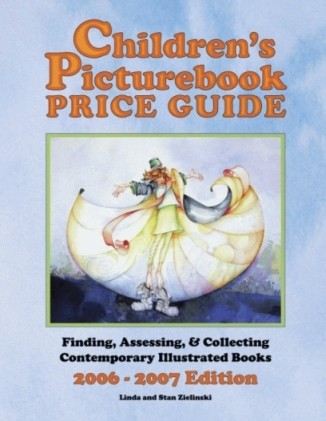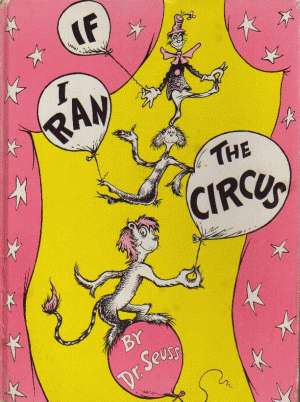Factors Affecting The Value Of Children's Books: Copies Sold
 In general, the more copies sold over time, or the greater number of printings, the more collectible will be the true first printing of a picturebook. The caveat is the first print run cannot be a large percentage of the books that were printed. It makes common sense, but bears repeating: the demand increases over time while the original supply of true first printings actually decreases over time, through attrition (i.e. damaged or discarded), or by being absorbed into book collectors' libraries. In either case, the availability or supply of the first edition book is reduced to the collecting marketplace.
In general, the more copies sold over time, or the greater number of printings, the more collectible will be the true first printing of a picturebook. The caveat is the first print run cannot be a large percentage of the books that were printed. It makes common sense, but bears repeating: the demand increases over time while the original supply of true first printings actually decreases over time, through attrition (i.e. damaged or discarded), or by being absorbed into book collectors' libraries. In either case, the availability or supply of the first edition book is reduced to the collecting marketplace.
Large Number Of Print Runs
Picturebooks get into high print runs for a number of reasons, many of which have been previously mentioned. The key factor to a book's long-term popularity is the high appeal of the illustration and story, and especially if that appeal is generational in nature - refer to Key Factor #1, Aesthetic Quality of the Illustrations and the Story. Another leading cause is the book crossing over into popular culture, cementing demand for years to come.
Chapter 3, "Approaches To Collecting," contains a section on bestselling children's books, compiled by Publisher's Weekly. The number one bestselling children's book is a Little Golden Book, The Poky Little Puppy, which has sold over 14 million copies. Since only a small percentage of those were first edition printings, the number of copies sold, which is directly related to the number of people who have read the book (and therefore are potential collectors), is a major contributing factor to the high collectibility and market value of the book.
Another example is Shel Silverstein's The Giving Tree, published initially in 1964, and has sold over 5.6 million copies. Although Silverstein had several books published prior to The Giving Tree, it was his first of several phenomenally successful books. Because of this, the initial printing of The Giving Tree is relatively small compared to the total number of copies sold, therefore the first edition copies have a high market value.
Silverstein's Where The Sidewalk Ends has sold even more copies, some 6.2 million copies, however the first edition copy does not have near the market value of The Giving Tree. Since Where The Sidewalk Ends was published in 1974, after a decade of successful sales of the The Giving Tree, the publisher had a good idea of success in the market, and therefore there were substantially higher first printing copies produced.
Number Of Copies Sold Compared With Number Of Print Runs
The number of printings is probably more important then the number of copies sold, although obviously the two are interrelated. As an example of this, the Disney books that accompany their marquee animated movies are sold in very high numbers, but don't get into especially high number of print runs. The number of first editions of these Disney books is quite high relative to the number of total books sold. There is not a high chance for high appreciation in the future.
On the other hand, a book such as The Polar Express, by Chris Van Allsburg, has had over 70 printings in its twenty-some year publication history, which is quite remarkable for a relatively new book. The collectibility and value of The Polar Express is enhanced by the combination of the high number of copies sold, meaning a large number of children and adults who have read or been exposed to the book, and the relatively low number of first editions that were initially printed. There are many, many examples of this, and most of the books in Most Valuable Books, reflect this trait.
Six Key Factors
 The collectible contemporary children's book market is evolving and maturing, although the hobby
has not yet reached adolescence. The factors that affect a book's value and collectibility are
not solidified within the hobby. The current state is Caldecott and Seuss-centric, synchronous
with 'mainstream' collectible books, in that every bookseller KNOWS they have value.
However I believe the hobby will mature into something significantly different.
The collectible contemporary children's book market is evolving and maturing, although the hobby
has not yet reached adolescence. The factors that affect a book's value and collectibility are
not solidified within the hobby. The current state is Caldecott and Seuss-centric, synchronous
with 'mainstream' collectible books, in that every bookseller KNOWS they have value.
However I believe the hobby will mature into something significantly different.
With this in mind, we've identified six factors which affect the collectibility and value of a contemporary children's picturebook. The six factors are a starting point for dialogue within the hobby, which will create some controversy and discourse. Over time, this collaborative tension will lead to evaluation and evolution of the factors generally accepted to affect a book's value and collectibility. Eventually these factors will become solidified within the hobby.
The six factors are intimately connected, so it is difficult to individually describe one without intermingling the description with the other factors. One factor will invariably impact other factors. Not one to retreat from a challenge, we will try nonetheless.
© Stan Zielinski
A serious collector having fun with fun books.
Attribution
© Stan Zielinski. Author of the Children's Picturebook Price Guide

This
work is licensed under a
Creative Commons Attribution-NonCommercial-ShareAlike 3.0 License.
In layman's terms, that means you may excerpt, share, and use this material as long as you credit Stan as the author and provide a link back to the specific content page. And do not sell it or use it for commercial purposes.
The information offered on 1stedition.net and the blog is offered free of charge. Any uses, references, and or copies of this website in whole or in part must include the bibliographic citation, including author attribution, article title, date (in the case of blog posts) and link to the URL 1stedition.net. Include the copyright notice.
In no event shall a Creative Commons Attribution License or Stan Zielinski be liable for any damages of any kind arising out of or in connection with the use of the articles on this website. This website is provided "as is" without warranty of any kind, either expressed or implied. Descriptions of, or references to, persons, websites, or businesses does not imply endorsement of that person, website or business.